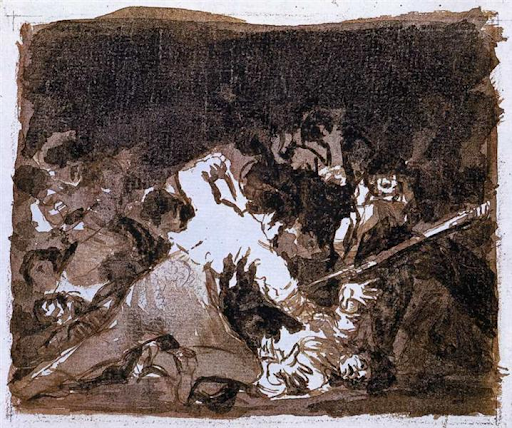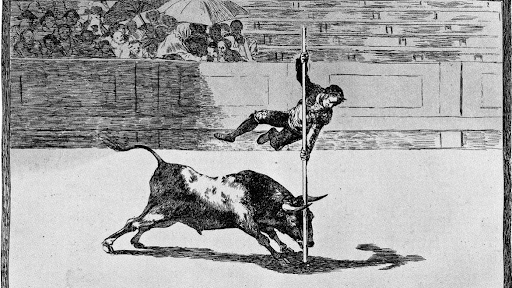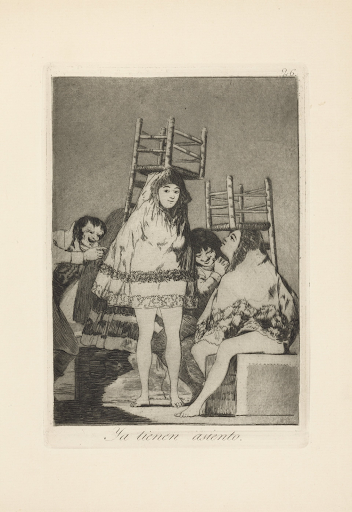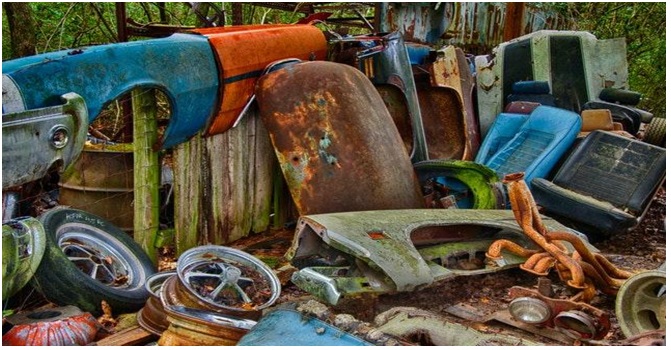Francisco de Goya (1746 – 1828) was a Spanish romantic painter and printmaker. Art scholars consider him the most important Spanish artist of the late 1700s and early 1800s. Francisco Goya’s art includes paintings, drawings, and engravings, and he had a significant influence on 19th- and 20th-century painters. Most art lovers and scholars describe Goya as the last of the Old Masters and the first of the moderns.
He was also the first significant artist who used the aquatint technique. Although he was not the inventor of aquatint, he worked a lot with the relatively new technique. Indeed, around 1650, the technique was invented by the printmaker Jan van de Velde IV in Amsterdam.
The aquatint technique exposes a copperplate to acid through a layer of melted granulated resin. Printmakers have widely used it, and the technique is called aquatint because the finished prints often resemble watercolor drawings.
Table of Contents
More About the Aquatint Technique
The aquatint is an intaglio printmaking technique. “Intaglio” is the name used for the printing and printmaking techniques where the image is incised into a surface. It is important to note that Intaglio techniques, and thus also the aquatint technique, are the opposite of a relief print. With relief printing, the parts of the matrix that make the image stand above the main surface.
Aquatint was primarily used in conjunction with etching, but it has also been used historically to print in color. That was done by printing with multiple plates in different colors or making monochrome prints that were then hand-painted with watercolor.
The aquatint technique has been used frequently since the late 1700s and was widely used between 1770 and 1830 for artistic and decorative prints. However, after about 1830, lithography and other techniques became more popular.
In the late 18th-century, beginning 19th-century, Francisco Goya was the first significant artist to use the aquatint technique extensively. Unfortunately, an aquatint plate wears out relatively quickly. As a result, many plates with Francisco Goya art were reprinted too often posthumously, and poor impressions resulted.
More About Francesco de Goya
Francesco de Goya was born to a middle-class family in 1746 in Aragon. He studied painting from age 14 and later moved to Madrid to further his art studies. In 1773 he got married, and only one of his sons survived into adulthood.
In 1786, Goya became a court painter for the Spanish Crown. During this early part of his career as an artist, he created many portraits of the Spanish aristocracy and Rococo-style tapestry cartoons for the royal palace.
He became deaf in 1793 after a severe illness, and his work became progressively darker and more pessimistic. He became withdrawn and introspective, and the tone of his work changed. He began the series of acquainted etchings during that period, published in 1799 as the Caprichos.
At the same time, he was also made Director of the Royal Academy, and in 1799 he became “Primer Pintor de Cámara” (Prime Court Painter) – the highest rank for a Spanish court painter. After that, he withdrew from public life, and from the late 1810s, he lived in near-solitude outside Madrid in a farmhouse cum studio.
Goya’s Aquatint Printmaking Application
The works of artist Francesco Goya include four major print series, namely “Los Caprichos,” “The Disasters of War,” “La Tauromaquia,” and “Los Proverbios.” He used the aquatint technique in all four series. All four were done in engraving, and he usually worked on a copper plate after making a preliminary drawing for guidance. He then dampened the paper and put a wax-like ground on the plate. The drawing was then placed face down on the plate.
His next step was to run the paper and plate through a press so that a copy of the drawing would transfer to the ground. He then worked over the lines on this ground with an etching needle and put the plate in acid. The plate would be protected throughout except for the places where lines were drawn. Furrows were eaten away by the acid.
He then took the ground off the plate to be inked. The furrows hold the ink even after the plate had been wiped. The final step in his etching process was to press a sheet of damp paper over the inked plate. The damp paper picked up the lines of ink.
To get shading areas, Goya went a step further with the use of aquatint. Areas of the plate were roughened with acid to enable them also to hold ink and thus print as tone. Sometimes, he applied acid to an area twice to make the holes deeper. As a result, those areas held more ink, and the area would print darker than the rest.
” Los Caprichos”
Los Caprichos – Goya
“Los Caprichos” is the earliest of the significant Goya print series. It is a series of 80 engravings published by Goya in 1799. The early proofs, and a few complete early sets, are well documented, and their current locations are known. Many sets were made later from the same plates.
As all the later posthumous edition impressions have been taken from the original plates, they are to a certain extent “original Goya prints.” Art connoisseurs, however, prefer the first edition impressions.
“The Disasters of War”

War scene – Goya
“The Disasters of War” is the second series of Goya prints. The prints were created in 1811-12 during the Napoleonic Wars and the Great Famine in Madrid.
Materials were scarce, and Goya had to be satisfied with previously used plates. In fact, he worked on the back of the old plates. As a result, even the first impressions lack the usual clarity of aquatint shading. Nevertheless, because of Goya’s problems in getting material, art scholars regard this series as one of the greatest artistic and printmaking achievements ever.
”La Tauromaquia” and “Los Proverbios”

La Tauromaquia – Goya
The “La Tauromaquia” series’ 33 original plates were created in about 1815-1816 and were printed in an edition by Goya.
The last series comprises eighteen “Proverbios” prints. They were made from about 1815 to 1824. Goya made a few proofs of these prints, but no edition was produced. His son Javier stored the plates and re-discovered them only after Javier’s death. This series was never published during Goya’s life.
Conclusion
The aquatint technique invented in 1650 was made famous by the artist Francesco Moya. His four series of prints, “Los Caprichos,” “The Disasters of War,” “La Tauromaquia,” and “Los Proverbios,” are seen by art lovers and scholars as the best examples of this technique.



